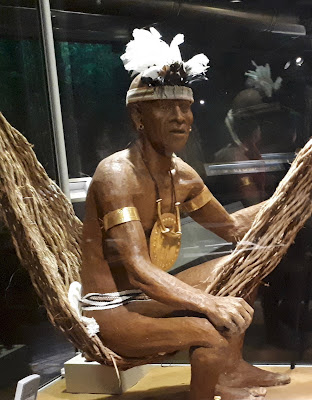As we had a free morning before boarding our ship, we joined a small group to visit the National Theatre and and the Gold Museum.
The National Theatre of Costa Rica
The theatre opened in 1897 after seven years of construction. There were many problems during construction and an Italian engineer was eventually brought in to complete the project. The building is a great example of rococo design, with lots of dense ornamentation and gilding. It is one of the few older buildings in San Jose, as most have been destroyed by earthquakes. The theatre also suffered damaged and we were told that the restoration used less gilt ornamentation.
 |
| These sheltered boxes allowed widows to attend the theatre, as they were not supposed to attend social events. |
 |
| The elegant reception area has a smoking room for gentlemen and another for ladies to retire. |
 |
The boxes were open at the sides, much different from the privacy
afforded to patrons in the Odessa theatre, which had walls almost to the front railing. |
The Pre-Columbian Gold Museum
The Gold Museum is located underground, beneath the plaza. Given the frequency of earthquakes in Costa Rica, this seemed to be an excellent idea. Its acquisitions include 3,567 gold, ceramic and stone objects.
 |
| The entrance to the Gold Museum is on the lower right. |
The early ceramics were wonderfully made, with exquisite detail. Later pieces were more crude, reflecting changes in political, economic and social climates.
 |
| One of my favourite pieces, dating from 1000-1300 AD, incorporating the figure of a jaguar. |
 |
| This pot is not as finely finished but it has a remarkable creature on the top. They often incorporated reptiles such as iguanas, caimen or crocodile, as a tribute to the role they played as guide, protector or men-killer, 300-800 AD |
 |
| Engaging bowl with bird figure Central Caribbean, 300 BC-300 AD |
 |
| This is a metate - a flat or slightly hollowed oblong stone on which materials such as grain and cocoa are ground using a smaller stone. It is the size of a small bench from around 800-1500 AD. They were used as a burial covering or offering in the graves of important people in the northern and central regions of Costa Rica. |
And then there was the gold! Hundreds of small golden figures - human figures, crocodiles, birds, frogs, as well as bells in different sizes. Some were cast figures while others were hammered.

 |
| The life-sized figures helped to see how the ornaments might have been worn. |
 |
| The 'fish hook' shapes puzzled me until I saw the figure below wearing one in his chin! |
 |
| The little frogs, ranging in size from 5-10 cm, were rich in detail. |
 |
The
alligator motif began to appear in jade, stone, ceramic and gold figures around
300 AD.
Its most important meaning was to represent the power and prestige of
shamans and healers.
|
 |
| I liked the placement of the golden jaguar beside the mounted one. |
 |
The human figures were used by the shamans in rituals.
Shamans enjoyed great prestige and power, as they had extensive
knowledge of ancestral history and myths.
One of their functions was to control the economic and political activities of their people.
The shamanic rituals enabled them to ascend to higher planes of reality and
enter into contact with supernatural forces, with whom they interceded
to ensure the welfare of the community or of an individual. |
We felt lucky to have been able to experience this museum.

























No comments:
Post a Comment